ATTENTION
Our Henderson Nevada Location is
a Mail-Order Warehouse,
No Showroom.
Pickups and visits by appointment only.
ORDERS or Returns: Call for authorization
ORDERS 702-419-3070 – Thank you.
ORDERS or Returns: Call for authorization first: 702-419-3070 - No showroom
We are a mail order warehouse. Curbside no-contact pickup by appointment only.




Gold Is Not Where You Find It, by Doc as appeared in GPAA Magazine
Gold Is NOT Where You Find It!
by Doc as Published in GPAA Magazine
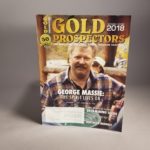
I am always dismayed when I hear about fellow detectorists who say that they have yet to find a piece of gold with their metal detector after one year, two years, etc.
I find gold almost every time I go detecting. I may get skunked one out of twenty times. That one time is usually when I am prospecting totally new ground, and just have not hit a new patch yet.
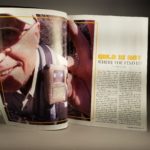 We all have heard the saying, “Gold is where you find it.” I think that statement is wrong, very misleading and harmful.
We all have heard the saying, “Gold is where you find it.” I think that statement is wrong, very misleading and harmful.
In fact, I think it may give newbies the wrong impression about prospecting for gold. It implies that gold is randomly dispersed with no rhyme or reason, and if you do happen to find it, it is only by some strange coincidence or luck. Nothing could be further from the truth. Finding gold is a science and an art, executed by people with the skill and experience who know what they are doing and where to look.
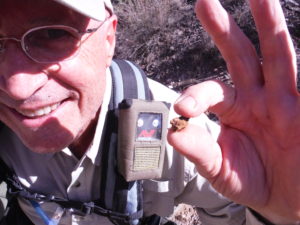
Let’s start with understanding some basic truths. All we are doing with a metal detector is processing dirt. The same way you process dirt with a dry washer, or a high banker. We are just doing it electronically. The more dirt we process the better chance we have of finding gold. But think of what a small amount of dirt we are processing with a metal detector. A column of dirt under the coil to an indeterminate depth and we sweep that coil back and forth. We do that for 6 to 8 hours a day? 
Now compare that to the tons and tons of dirt you see the boys on the hit television show Gold Rush process. Yards and yards and tons and tons of dirt processed to collect their gold. It’s amazing that we find anything when you compare the small amount of dirt we “process” with a metal detector.
So, think about what a bizarre feat it is for a person with a metal detector to process such a small amount of dirt, and yet be able to find gold. It truly is akin to the old saying “a needle in a haystack.”
Yet, we all know experienced prospectors, who are always posting pictures of their gold finds. These are prospectors that have been around a while. These prospectors that consistently find gold with their metal detectors, become pretty well known, pretty quickly, because there just aren’t that many of them. They become something of celebrities. Many of these “legends” are featured at the GPAA shows to give informative and invaluable talks. So how come some of these people are more successful at finding gold than other people? Do we process more dirt? NOPE! We have a secret!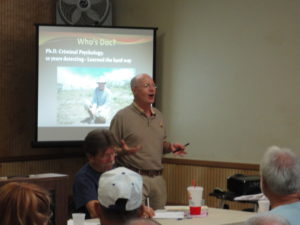
Our secret is we spend our time processing dirt that is more likely to have gold, than other dirt.
We have all heard go low and go slow when using a metal detector. I agree with that “go low” admonishment. You need to keep that coil on the ground. But SLOW? If you watch experienced detectorists, you will see that they vary their speed when they are “looking for gold.” They speed up in areas that their knowledge and experience tell them they are less likely to find gold. Then, they slow down in areas where that experience tells them there may be a greater chance for there to be gold. They spend their time more productively by processing only dirt that has a higher probability of having gold. When they find a nugget, they may turn around and go back over the area they went through quickly. This time they will go more slowly. They do this because they now know this area may be more likely to have gold too. So they invest their time wisely; only spending valuable time processing high probability ground.
Let me provide an outlandish example. You are standing in a paved parking lot of a large supermarket. Next to the supermarket parking lot are acres and acres of quartz strewn red dirt with all kinds of gullies where water has ran during the wet season. Where are you most likely to find gold? Are you going to spend your day in the supermarket parking lot swinging over asphalt? Experienced detectorists are constantly looking at their surroundings. They look at where they are going and where they have been. They are calculating the odds. Is this a supermarket parking lot, or a gold vault?
“Gold is NOT where you find it.”
“Gold is found in places it is most likely to be.”
Seasoned prospectors have spent their careers learning what those places look like. Now are we ever surprised to find a nugget in a place where we would never intentionally look. Certainly, but those are few and far between.
Most of the time when we find a nugget we have a pretty good idea of why it is where it is. 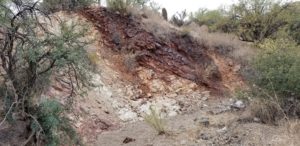 We may observe contact zones of granite and quartz with iron staining, deteriorated quartz is everywhere, we detect on a bench, in a tailings pile, a narrow gully with high sides, in the bend of a gully, under a waterfall of boulders, behind a bush lining a gully, near an old mine or where there are indications the old timers were working.
We may observe contact zones of granite and quartz with iron staining, deteriorated quartz is everywhere, we detect on a bench, in a tailings pile, a narrow gully with high sides, in the bend of a gully, under a waterfall of boulders, behind a bush lining a gully, near an old mine or where there are indications the old timers were working.
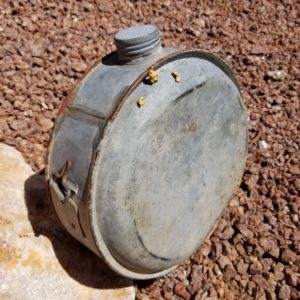 I once was way off the beaten path on my ATV. I found an old canteen that said BEAR BRAND, Patent 1918; lid still on it, canvas completely gone. I stopped right there and detected the gully I found it in. I pulled out three nice little nuggets.
I once was way off the beaten path on my ATV. I found an old canteen that said BEAR BRAND, Patent 1918; lid still on it, canvas completely gone. I stopped right there and detected the gully I found it in. I pulled out three nice little nuggets.
Let’s say after a year you finally find your first nugget. You find it under a boulder right on the side of a gully. From that day forward, you will check every boulder on the side of every gully. Why? You learned where to look. It’s no coincidence that after taking so long to find the first nugget, newbies generally find their second nugget soon thereafter. WHY? Knowledge and confidence. I have often said, if you don’t take at least 20 minutes with every nugget you find, letting it tell you it’s story, you are missing a valuable education. “How did you get here little buddy? Why did you stop here? Where did you come from? What’s different about this gully than other gullies I have checked? Is there a concentration of deteriorated quartz around here? A contact zone? You’re sort of rough, you didn’t travel far did you? Where are your little friends?”
I can almost bet that any experienced prospector will tell you that they can be riding on their ATV and they will come upon a patch of ground and their heart starts beating a little harder. They may even say to themselves out loud, “Oh man this area looks good.” After years and years of experience, we sometimes just “get a feeling.” It’s not voodoo, it’s just our subconscious telling us that at some time in our past, we came across a place that exhibited similar conditions, and we found gold there. We may not even remember the specifics of that area in our past on a conscious level, but our sub-conscious knows.
So what is the moral of this story? Buying a detector and expecting to learn how to become a successful prospector without training is like buying a 747 aircraft and trying to get it airborne when you have had no training.
I hear it time and time again. I’ve been detecting two years and never found a piece of gold. “Who trained you?” TRAINED ME? “Well I’ve done a lot of research and I have read a lot on detecting and prospecting and I have 13 books on prospecting in my library.”
You board a commercial airline and the captain comes on the intercom and says, “I’d like to tell you a little about my knowledge about flying. I’ve done a lot of research on flying an airplane. I have read a lot on aviation and I have 13 books on the history of aircraft development in my library.”
Ah, put on your seat belt, and make sure you know where the emergency exits are. Scratch that, just get off the plane!
Someone tells you they have not been successful with a metal detector. They go on to explain they have never been trained to use their metal detector, or been taught to properly prospect for gold. That is akin to someone saying, “I have had the worst luck with airplanes. I have owned five different planes and can’t get the darn things in the air; I have crashed every one of them.” Where did you get your flight lessons? “ME? LESSONS? YOU MEAN FLYING LESSONS?”
So boys and girls, my lesson for today is:
“Gold is NOT where you find it.”
“Gold is found in places it is most likely to be.”
So hang out with people who can help you and teach you WHERE to look!
A company who only sells you a detector, is doing just that. They are selling you a detector. There is nothing wrong with that if you are a seasoned veteran who does not need training, or if you have someone who is willing to take you under their wing and teach you this wonderful past-time.
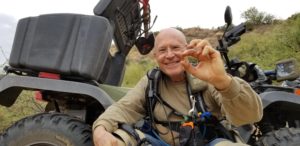 However, if you are new, or not successful at finding gold, look for metal detector dealers who also offer training. Then you are not just buying a detector. You are investing in a relationship with someone who wants to make sure you are successful at learning how to prospect and find gold. Whatever you invest financially for training will pay huge dividends when it comes to being successful at finding gold.
However, if you are new, or not successful at finding gold, look for metal detector dealers who also offer training. Then you are not just buying a detector. You are investing in a relationship with someone who wants to make sure you are successful at learning how to prospect and find gold. Whatever you invest financially for training will pay huge dividends when it comes to being successful at finding gold.
I have been a metal detector dealer for 26 years. I have trained detectorists from all around the world. I have even gone to North Sudan and trained prospectors there. When I sell a customer a metal detector I recommend two things. Sign up for a training class and join the GPAA local chapter. Go to the meetings and attend the outings. Local GPAA chapters are a treasure trove of knowledge. They exist for one sole purpose: to make sure you become a successful gold prospector. A membership in the GPAA is the most valuable and least expensive investment in fun you will ever make.
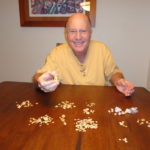 G.M. “Doc” Lousignont, Ph.D. has a Ph.D in Criminal Psychology, a former law enforcement officer and a licensed private investigator for 41 years, his love of solving mysteries led him to prospecting. In 1992 he opened his prospecting supply store Doc’s Detecting Supply, located in a new 4500 sq foot warehouse at 1180 Wigwam Parkway, Suite 110, Henderson, Nevada 89074. Ph 1-800-477-3211 Doc is a leading dealer for Minelab Metal Detectors. His numerous training videos are available on YouTube on his channel Docsdetectingsupply
G.M. “Doc” Lousignont, Ph.D. has a Ph.D in Criminal Psychology, a former law enforcement officer and a licensed private investigator for 41 years, his love of solving mysteries led him to prospecting. In 1992 he opened his prospecting supply store Doc’s Detecting Supply, located in a new 4500 sq foot warehouse at 1180 Wigwam Parkway, Suite 110, Henderson, Nevada 89074. Ph 1-800-477-3211 Doc is a leading dealer for Minelab Metal Detectors. His numerous training videos are available on YouTube on his channel Docsdetectingsupply





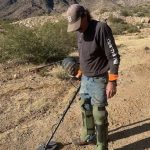




Hi doc. I saw your 12 foot dune sport trailer on u tube. I like the layout and was wondering what the total cost was. I want to haul my triglide with me. I also am into detecting and gold sluicing. Going to retire soon and want to have the toy hauler like yours.
$23000